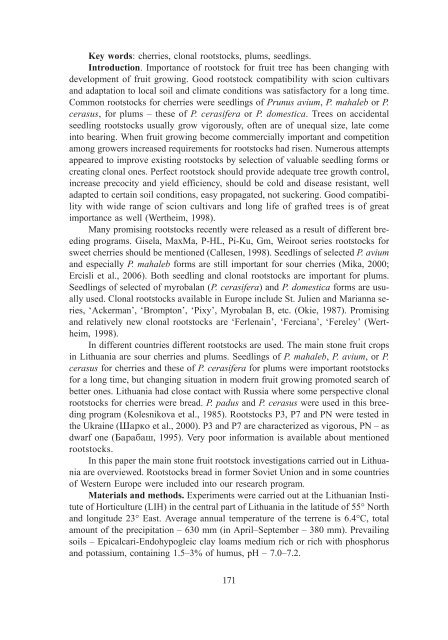You also want an ePaper? Increase the reach of your titles
YUMPU automatically turns print PDFs into web optimized ePapers that Google loves.
Key words: cherries, clonal rootstocks, plums, seedlings.<br />
Introduction. Importance of rootstock for fruit tree has been changing with<br />
development of fruit growing. Good rootstock compatibility with scion cultivars<br />
and adaptation to local soil and climate conditions was satisfactory for a long time.<br />
Common rootstocks for cherries were seedlings of Prunus avium, P. mahaleb or P.<br />
cerasus, for plums – these of P. cerasifera or P. domestica. Trees on accidental<br />
seedling rootstocks usually grow vigorously, often are of unequal size, late come<br />
into bearing. When fruit growing become commercially important and competition<br />
among growers increased requ<strong>ir</strong>ements for rootstocks had risen. Numerous attempts<br />
appeared to improve existing rootstocks by selection of valuable seedling forms or<br />
creating clonal ones. Perfect rootstock should provide adequate tree growth control,<br />
increase precocity and yield efficiency, should be cold and disease resistant, well<br />
adapted to certain soil conditions, easy propagated, not suckering. Good compatibility<br />
with wide range of scion cultivars and long life of grafted trees is of great<br />
importance as well (Wertheim, 1998).<br />
Many promising rootstocks recently were released as a result of different breeding<br />
programs. Gisela, MaxMa, P-HL, Pi-Ku, Gm, We<strong>ir</strong>oot series rootstocks for<br />
sweet cherries should be mentioned (Callesen, 1998). Seedlings of selected P. avium<br />
and especially P. mahaleb forms are still important for sour cherries (Mika, 2000;<br />
Ercisli et al., 2006). Both seedling and clonal rootstocks are important for plums.<br />
Seedlings of selected of myrobalan (P. cerasifera) and P. domestica forms are usually<br />
used. Clonal rootstocks available in Europe include St. Julien and Marianna series,<br />
‘Ackerman’, ‘Brompton’, ‘Pixy’, Myrobalan B, etc. (Okie, 1987). Promising<br />
and relatively new clonal rootstocks are ‘Ferlenain’, ‘Ferciana’, ‘Fereley’ (Wertheim,<br />
1998).<br />
In different countries different rootstocks are used. The main stone fruit crops<br />
in Lithuania are sour cherries and plums. Seedlings of P. mahaleb, P. avium, or P.<br />
cerasus for cherries and these of P. cerasifera for plums were important rootstocks<br />
for a long time, but changing situation in modern fruit growing promoted search of<br />
better ones. Lithuania had close contact with Russia where some perspective clonal<br />
rootstocks for cherries were bread. P. padus and P. cerasus were used in this breeding<br />
program (Kolesnikova et al., 1985). Rootstocks P3, P7 and PN were tested in<br />
the Ukraine (Øàðêî et al., 2000). P3 and P7 are characterized as vigorous, PN – as<br />
dwarf one (Áàðàáàø, 1995). Very poor information is available about mentioned<br />
rootstocks.<br />
In this paper the main stone fruit rootstock investigations carried out in Lithuania<br />
are overviewed. Rootstocks bread in former Soviet Union and in some countries<br />
of Western Europe were included into our research program.<br />
Materials and methods. Experiments were carried out at the Lithuanian Institute<br />
of Horticulture (LIH) in the central part of Lithuania in the latitude of 55° North<br />
and longitude 23° East. Average annual temperature of the terrene is 6.4°C, total<br />
amount of the precipitation – 630 mm (in April–September – 380 mm). Prevailing<br />
soils – Epicalcari-Endohypogleic clay loams medium rich or rich with phosphorus<br />
and potassium, containing 1.5–3% of humus, pH – 7.0–7.2.<br />
171

















